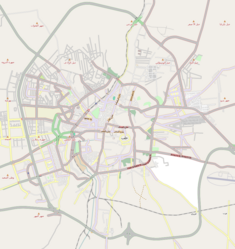Waqf of Ibshir Mustafa Pasha Complex
| Waqf of Ibshir Mustafa Pasha | |
|---|---|
| Native name Arabic: وقف ابشير باشا | |
 Water fountain of the Waqf Ibshir Mustafa Pasha Complex | |
| Location | Al-Jdayde, Aleppo, Syria |
| Coordinates | 36°12′23.2″N 37°09′25.4″E / 36.206444°N 37.157056°ECoordinates: 36°12′23.2″N 37°09′25.4″E / 36.206444°N 37.157056°E |
| Built | 1652 |
 Location of Waqf of Ibshir Mustafa Pasha in Aleppo | |
The Waqf of Ibshir Mustafa Pasha (AR: وقف ابشير باشا) is a sizeable 17th century endowment complex built by wazir Ipshir Mustafa Pasha in 1652 who was then governor of Aleppo.
Background[]
The Ibshir Mustafa Pasha Waqf complex is one of a number of notable historic structures built in 17th century Aleppo.[1] The complex included a khan, three qaysariyya, textile looms and dye workshop, a souk, bread ovens, a sebil and a coffee-house noted for its fine decorations.[2][3] The Bahram Pasha waqf hammam's lies in an adjacent building. They provided a shared 'public' space and commercial opportunity for local Christian and Muslim inhabitants and led to its neighbourhood of Al-Jdayde to become Aleppo's second economic centre.[4][5][6] Aleppo's Beit Ghazaleh and Beit Ajikbash museums lie adjacent to the waqf complex.[4]
Recent developments[]
The complex suffered damage from street fighting and intermittent shelling throughout Syria's civil war. In particular, a series of underground explosions that occurred in April 2015 devastated the building and surrounding area.[7][8][9]
The waqf complex is listed as one of 25 most significant restoration sites proposed for the Ancient City of Aleppo.[10]
Further reading[]
- David, Jean-Claude. Le waqf d’Ipšīr Pāšā à Alep (1063/1653): Étude d’urbanisme historique. Avec la collaboration de Bruno Chauffert-Yvart. Damascus: Presses de l'Ifpo, 1982. (in French)
- L.I.S.A.teamwork Gerda Henkel Stiftung (2017) The Waqf of Ibshir Mustafa Pasha | وقف ابشير باشا (in English)
- Watenpaugh, Heghnar Zeitlian.(2004) The Image of an Ottoman City: Imperial Architecture and Urban Experience in Aleppo in the 16th and 17th Centuries. Leiden: Brill
- Die Organisation des religiösen Raums in Aleppo. Die Rolle der islamischen religiösen Stiftungen (auqāf) in der Gesellschaft einer Provinzhauptstadt des Osmanischen Reiches an der Wende zum 19. Jahrhundert. Beirut: Orient-Institut Beirut, 2009. (in German)
- Jean-Claude David, Thierry Boissière. (2014) La destruction du patrimoine culturel à Alep : banalité d’unfait de guerre?. Confluences [en] Méditerranée, l’Harmattan 2014/2 N.89 pp.163-171 (in French)
- Stefan Knost (2015) The Christian Communities in Ottoman Aleppo and the Role of Religious Endowments (Waqf), in: Hidemitsu Kuroki (ed.), Human Mobility and Multi-ethnic Coexistence in Middle Eastern Societies 1, pp. 41-57.
Gallery[]

Facade of Waqf Cafe

Waqf cafe interior

Dome of Waqf Cafe

Rooftop view over Waqf Hammam
References[]
- ^ Stefan Knost. "The Waqf of Ibshir Mustafa Pasha | وقف ابشير مصطفى باشا Urban and social historical background". L.I.S.A. WISSENSCHAFTSPORTAL GERDA HENKEL STIFTUNG. Retrieved 2019-06-13.
- ^ David, Jean-Claude (2015-03-16). Le Waqf d'Ipšīr Pāšā à Alep (1063-1653) : Étude d'urbanisme historique. Études arabes, médiévales et modernes (in French). Beyrouth: Presses de l’Ifpo. ISBN 9782351595077.
- ^ Deguilhem, Randi. "Waqf in the City" (PDF). The City in the Islamic World. 94/1 & 94/2: 932.
- ^ Jump up to: a b Stiftung, Gerda Henkel. "Waqf of Ibshir Mustafa Pasha - Urban and social historical background". L.I.S.A. WISSENSCHAFTSPORTAL GERDA HENKEL STIFTUNG. Retrieved 2019-06-13.
- ^ Deguilhem, Randi (2008-01-01). "The Waqf In The City". The City in the Islamic World (2 vols.): 929–956.
- ^ Ghazale, Pascale (2011). "Held in Trust: Waqf in the Islamic World". The American University in Cairo Press. ISBN 9789774163937. Retrieved 2019-11-19.
- ^ "ASOR Cultural Heritage Initiatives Weekly Report 38 (April 27, 2015)". ASOR Cultural Heritage Initiatives. 2015-05-28. Retrieved 2017-01-03.
- ^ Rami Alafandi, Issam Ballouz, Alaa Haddad (August 2017). "Damage assessment | تقييم الضرر". The Waqf of Ibshir Mustafa Pasha - Damage Assessment. Retrieved 2019-06-13.CS1 maint: multiple names: authors list (link)
- ^ Video Excerpt: Underground explosions in Al Jdayde April 2015 on and near Sahat al Hatab Aleppo, retrieved 2019-06-13
- ^ Directorate General of Antiquities and Museums & Aga Khan Trust for Culture (2019). [Draft] PLAN OF RECONSTRUCTION AND RECOVERY OF THE ANCIENT CITY OF ALEPPO Strategy and Proposed Restoration Projects. p. 194.
External links[]
- Buildings and structures in Aleppo
- Aleppo
- Architecture of Syria
- Jdeydeh quarter
- Lists of religious buildings and structures in Syria
- Syria stubs





